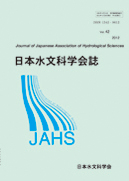All issues

Volume 42 (2012)
- Issue 4 Pages 147-
- Issue 3 Pages 87-
- Issue 2 Pages 29-
- Issue 1 Pages 1-
Volume 42, Issue 1
Displaying 1-2 of 2 articles from this issue
- |<
- <
- 1
- >
- >|
ORIGINAL ARTICLE
-
Mohammad ISLAM, Kazuhisa CHIKITA, Tomoyuki WADA, Takuma YAMAGUCHI2012 Volume 42 Issue 1 Pages 1-19
Published: 2012
Released on J-STAGE: June 30, 2012
JOURNAL FREE ACCESSThe soil water behaviors during rainfall or snowmelt events were explored by monitoring the soil moisture on the slope of forest and grassland in the Saromabetsu river basin, Hokkaido, in the summer season of 2008 and the snowmelt season of 2009. The river basin is covered mostly by forest (75.2% in area) and farmland (21.5 % in area; mainly grassland, wheat field and corn field). The soil layer, common to the slope of forest and grassland, consisted of porous organic layer (A layer) less than 0.3 m thick and organic/inorganic (B layer) about 10 m or more thick. The B layer is silty clay with low hydraulic conductivity of 10-4 cm/s order. The 4-channel profilers ( 8cm, 18cm, 28cm and 38cm in soil depth) for measurements of volumetric water content (cm3/cm3 ) indicated that, common to rainfall and snowmelt events, the 8-28 cm layer at forest stores infiltrated water for a few days after events, and then returns to the previous moisture level by gradual drainage. At grassland, the drainage after events was slight except for 8 cm depth. At a rainfall of more than 20 mm/h, the saturated zone appeared at 38 cm depth in forest and at depths of more than cm in grassland. Hence, in the events, the percolation and subsurface flow are judged to be active. The percolation at cm depth of forest and grassland was calculated for rainfall and snowmelt events. Meanwhile, runoff analyses by the tank model revealed that surface and intermediate runoffs occupy more 70% of rainfall or snowmelt runoffs in the Saromabetsu River. As a result, there existed the linear relationship between the total percolation and surface and intermediate runoffs for the runoff events. Hence, it is suggested that the surface and intermediate runoffs from runoff analyses occur as the percolation and subsequent subsurface flow below the soil surface layer.View full abstractDownload PDF (1459K)
SERIES
-
5. Groundwater of high alkalinity around the Tanzawa-mountains, JapanKazuhiro ITADERA2012 Volume 42 Issue 1 Pages 21-28
Published: 2012
Released on J-STAGE: June 30, 2012
JOURNAL FREE ACCESSDownload PDF (1140K)
- |<
- <
- 1
- >
- >|